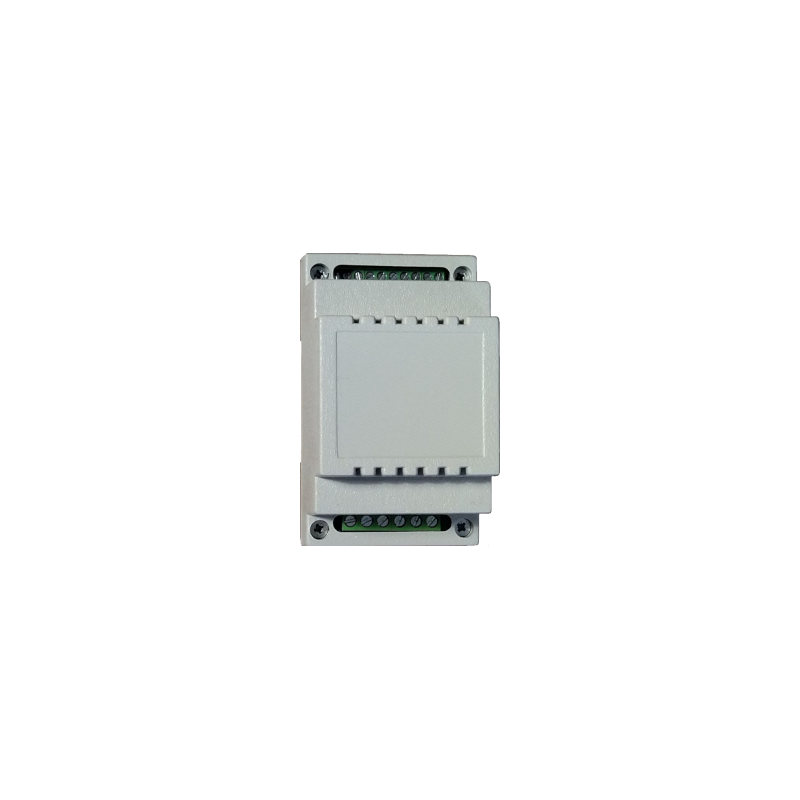

Email: store@creasol.it - Telegram: CreasolTech - Whatsapp: +393283730010
Prioritná pošta: rýchlo a lacno - Expresný kuriér: r
Pred vrátením produktov nás kontaktujte!

DomBus34 je aModul DIN-RAIL, šírka 54 mm,navrhnutý narozhranie až 4 merače výkonu/energie, typ DDS 238-2 ZN/S (Modbus), na mieruvýkon a energia (dovážané aj vyvážané), frekvencia napätia a účinník.
Realizuje2 reléové výstupy250V 5A SPST s prepäťovou ochranou,1 AC vstup110-240 Vac, a2 nízkonapäťové vstupyktoré možno pripojiť k tlačidlám a spínačom, dvojitým tlačidlám a počítadlám.
 Plná podpora: väčšina produktov je navrhnutá nami!
Plná podpora: väčšina produktov je navrhnutá nami!
Email: store@creasol.it - Telegram: CreasolTech - Whatsapp: +393283730010
 Objednávky sú odoslané do 1 pracovného dňa
Objednávky sú odoslané do 1 pracovného dňa
Prioritná pošta: rýchlo a lacno - Expresný kuriér: r
 Záruka 24 mesiacov, jednoduché vrátenie/vrátenie peňazí
Záruka 24 mesiacov, jednoduché vrátenie/vrátenie peňazí
Pred vrátením produktov nás kontaktujte!
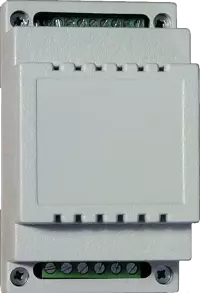 DomBus34 je aModul DIN-RAIL, šírka 54 mm,navrhnutý narozhranie až 4 merače výkonu/energie, typ DDS 238-2 ZN/S (Modbus), na mieruvýkon a energia (dovážané aj vyvážané), frekvencia napätia a účinník.
DomBus34 je aModul DIN-RAIL, šírka 54 mm,navrhnutý narozhranie až 4 merače výkonu/energie, typ DDS 238-2 ZN/S (Modbus), na mieruvýkon a energia (dovážané aj vyvážané), frekvencia napätia a účinník.
Realizuje2 reléové výstupy250V 5A SPST s prepäťovou ochranou,1 AC vstup110-240 Vac, a2 nízkonapäťové vstupyktoré možno pripojiť k tlačidlám a spínačom, dvojitým tlačidlám a počítadlám.
Je navrhnutý tak, abyaktivovať záťaže na základe dostupnosti energie, napríklad pri výrobe fotovoltaického alebo veterného systému, a dozobraziť pekné grafy so štatistikami o výrobe/spotrebe energies porovnaním na medziročnej báze.
Prepínanie záťaže je možné dosiahnuť pomocou príkazov DCMD, ale ako to fungujeDomoticzdomáca automatizáciasystém, je tiež ľahké ho vyrobiťvizuálne a textové skripty na vykonávanie aj zložitých automatizácií.
Rovnako ako ostatné moduly DomBus,všetky porty je možné konfigurovať mnohými rôznymi spôsobmia tiež tento modulpodporuje DCMD, príkazy odosielané do rovnakého alebo iného moduluvykonávať jednoduché činnosti, ktoré umožňujú dosiahnuť vysokú spoľahlivosť(Príkazy DCMD fungujú, aj keď ovládač domotic nefunguje) a jednoduché programovanie (nie je potrebné vytvárať automatizáciu v ovládači domotic, stačí nakonfigurovať porty DomBus na vykonávanie akcií s udalosťami). V neposlednom rade, rovnako ako ostatné moduly DomBus, je to <silný>optimalizované pre nízku spotrebu energie, menej ako 10 mW normálne (0,75 mA @ 13,6 V) a menej ako 150 mW, keď sú všetky relé zapnuté (10 mA @ 13,6 V).
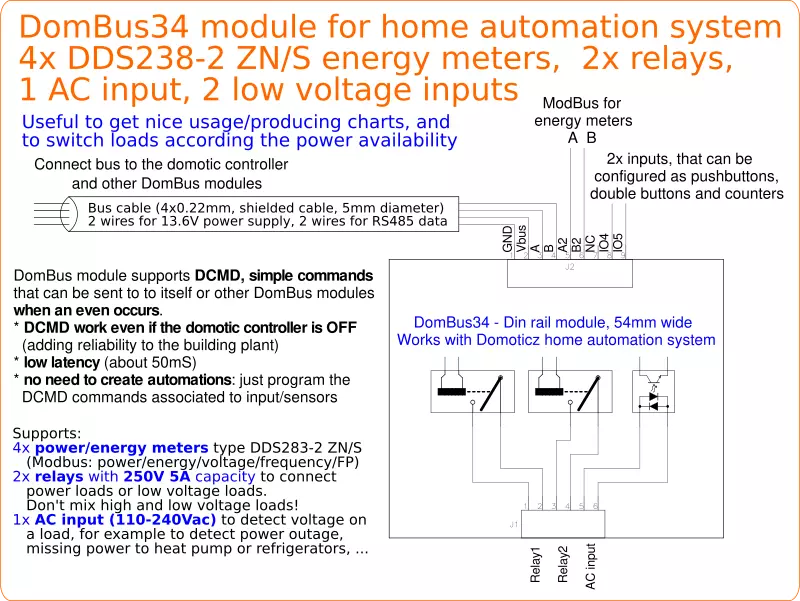
Elektromery DDS238-2 ZN/S sú z výroby naprogramované s adresou Modbus = 1. Zakaždým, keď sa k Modbus pripojí nový elektromer, jeho predvolená adresa by sa mala zmeniť na 2, 3, 4 alebo 5 výberom zariadeniaM1 adra zapíšte do zariadenia Popis ADDR=2, napríklad: týmto spôsobom bude elektromer s Modbus addr=1 naprogramovaný s novou zvolenou adresou.
Vždy, keď sa pridá nový elektromer, povolí sa nová sada zariadení, ktoré budú zobrazovať aktuálny importný a exportný výkon/energiu, napätie, účinník a frekvenciu.
* Skontrolujte stránku v angličtine, aby ste získali správne hodnoty príkazov!
Aj keď je možné vykonávať akúkoľvek automatizáciu pomocou funkcií ovládača domotic,základné automatizácie je možné vykonávať pomocou príkazov DCMD, ktoré sú vykonávané priamo modulom DomBus. Príkazy DCMD by mali byť špecifikované v popise zariadenia,fungujú aj v prípade, že je domotic controller offline a môže byť poslaný do toho istého modulu samotného alebo do iných modulov DomBuspripojený k tej istej zbernici.
Syntax jeDCMD(Udalosť:Nízka hodnota:Vysoká hodnota)=Adresa modulu.Port modulu:Príkaz:Hodnota
kde ValueLow, ValueHigh, Value sú voliteľné parametre.
<tr>VYPNUTÉK tomu dochádza aj vtedy, keď sa vstup (IO1, IO2 alebo INAC) vypne
DCMD(OFF)=3401.1:OFF Keď sa vstup vypne, vypne sa aj port 1 modulu 3401
DCMD(OFF)=3102.1:OFF Keď sa vstup vypne, vypne sa aj port 1 modulu 3102
| Udalosť | Popis | Príklad |
| ON | K tomu dochádza aj vtedy, keď je vstup (IO1, IO2 alebo INAC) zapnutý |
DCMD(ON)=3401.1:ON:90s Keď sa vstup zapne, zapne port 1 modulu 3401 na 90s DCMD(ON)=3102.1:ON Keď sa vstup zapne, zapne port 1 modulu 3102 |
| PULZ | Vstup je impulzne zapnutý na menej ako 0,5 s | DCMD(pulz)=13,3:PREPNÚŤ Keď vstup krátko pulzuje, pošlite príkaz do portu 3 modulu 13, aby ste prepli jeho výstup medzi OFF->ON alebo naopak |
| PULZ1 | Vstup je impulzne zapnutý asi 1 s |
DCMD(pulz1)=13,3:ON |
| PULZ2 | Vstup je impulzne zapnutý asi 2 sekundy |
DCMD(Pulse2)=13,3:OFF |
| PULZ 4 | Vstup je impulzne zapnutý asi 4 sekundy |
DCMD(pulz4)=13,4:ON:2h |
| VALUE | Hodnota snímača je ≥ ValueLow a < ValueHigh Ak sa porovnanie zhoduje, príkaz sa opakuje každých 30 sekúnd. |
DCMD(Hodnota:0:100)=31,8:VYP DCMD(Hodnota:0:248)=34,2:VYP |
Za predpokladu, že modul DomBus34 má adresu 3401, vyberte zariadenie Grid Import Energy a zapíšte do poľa popisu
DCMD(hodnota:1800:65000)=3401,1:ON
je možné nakonfigurovať zariadenie tak, aby automaticky aktivovalo relé1, keď je exportný výkon väčší alebo rovný 1800W ( napríklad na aktiváciu kotla alebo inej záťaže ).
Napísaním nasledujúceho príkazu na mriežku Import energie
DCMD(hodnota:500:65000)=3401,1:OFF,
modul DomBus34 bude nakonfigurovaný tak, aby deaktivoval relé1, keď je importovaný výkon väčší ako 500W . Toto správanie je riadené interne modulom DomBus34 a domotický ovládač bude informovaný o stave výstupu Relay1.
Podobne zapíšte nasledujúce príkazy do zariadenia Grid Voltage
DCMD(Hodnota:252:280)=3401,2:ON, DCMD(hodnota:0:248)=3401,2:VYP
je možné aktivovať výstup relé 2, keď napätie stúpne na 252 V alebo vyššie, deaktivovať relé 2, keď napätie klesne pod 248 V: toto môže byť užitočné počas leta, aby sa predišlo odpojeniu meniča (ochrana proti prepätiu) povolením záťaže alebo odpojením fotovoltaického reťazca.
Ak je výstup na aktiváciu/deaktiváciu v inom module DomBus, stačí zadať jeho adresu(napr. 0001.8)a tento výstup bude aktivovaný/deaktivovaný na základe aktuálnej hodnoty výkonu alebo napätia.
The following video shows a presentation of some domotic modules designed and produced in Italy by Creasol to make a reliable, easy and power-optimized home automation system.
The next video shows our Smart EVSE module that can be used to charge the electric car by using only solar power, or adding 25/50/75/100% of available power from the electrical grid.
Our industrial and home automation modules are designed to be
Modules are available in two version:
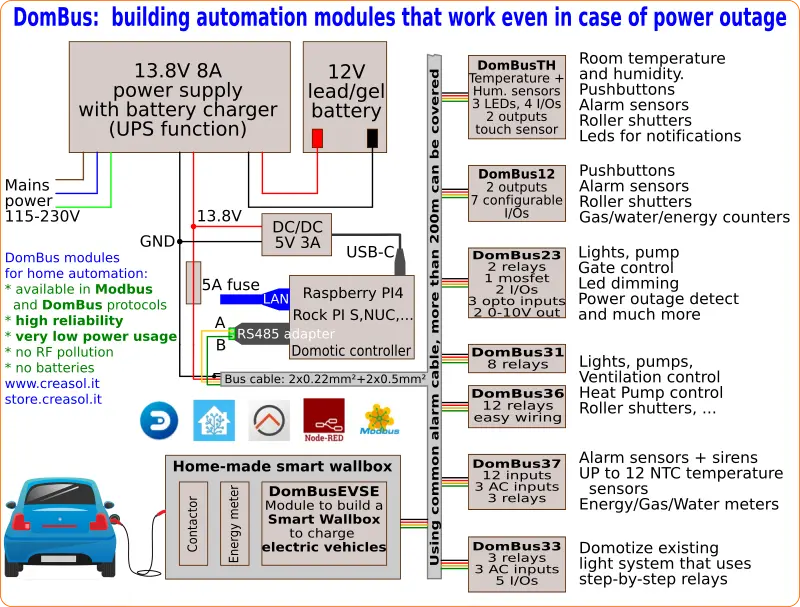
Store website - Information website
For our products we can offer FULL SUPPORT and CUSTOMIZATION: please contact us by Email or Telegram
 Complete solution to make a Smart EVSE, charging the electric vehicle using only energy from renewable source (photovoltaic, wind, ...), or adding 25-50-75-100% of available power from the grid.
Complete solution to make a Smart EVSE, charging the electric vehicle using only energy from renewable source (photovoltaic, wind, ...), or adding 25-50-75-100% of available power from the grid.
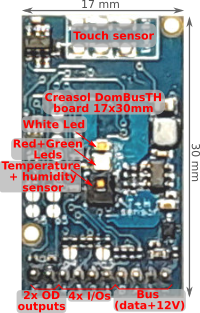 Compact board, 32x17mm, to be installed on blank cover with a 4mm hole in the middle, to exchange air for the relative humidity sensor. It can be installed in every room to monitor temperature and humidity, check alarm sensors, control blind motor UP/DOWN, send notifications (using red and green leds) and activate white led in case of power outage.
Compact board, 32x17mm, to be installed on blank cover with a 4mm hole in the middle, to exchange air for the relative humidity sensor. It can be installed in every room to monitor temperature and humidity, check alarm sensors, control blind motor UP/DOWN, send notifications (using red and green leds) and activate white led in case of power outage.
Includes:
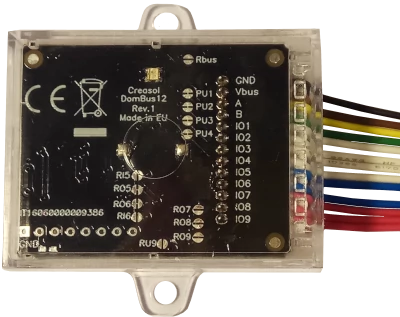 Very compact, versatile and cost-effective module with 9 ports. Each port can be configured by software as:
Very compact, versatile and cost-effective module with 9 ports. Each port can be configured by software as:
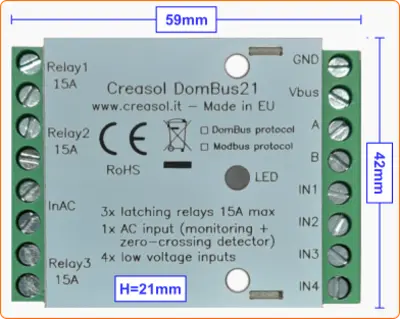 Very low power consumption module designed to enable up to 3 high power loads, up to 15A (3kW).
Very low power consumption module designed to enable up to 3 high power loads, up to 15A (3kW).
 Versatile module designed to control gate or garage door.
Versatile module designed to control gate or garage door.
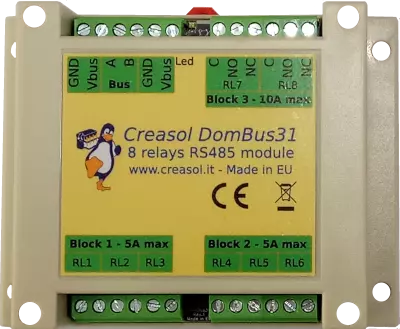 DIN rail low profile module, with 8 relays and very low power consumption:
DIN rail low profile module, with 8 relays and very low power consumption:
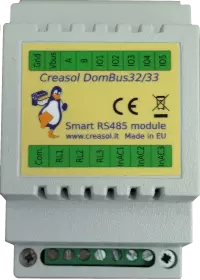 Versatile module with 230V inputs and outputs, and 5 low voltage I/Os.
Versatile module with 230V inputs and outputs, and 5 low voltage I/Os.
 Module designed to control 3 lights already existing and actually controlled by 230V pushbuttons and step-by-step relays. In this way each light can be activated by existing pushbuttons, and by the domotic controller.
Module designed to control 3 lights already existing and actually controlled by 230V pushbuttons and step-by-step relays. In this way each light can be activated by existing pushbuttons, and by the domotic controller.
Each relay can toggle the existing step-relay, switching the light On/Off. The optoisolator monitors the light status. The 5 I/Os can be connected to pushbuttons to activate or deactivate one or all lights.
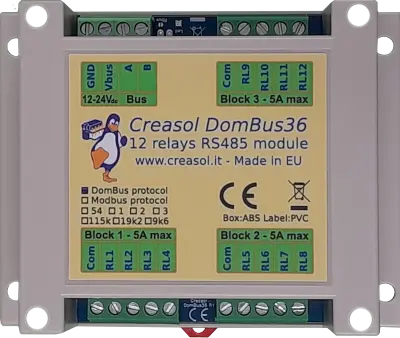 DIN rail module, low profile, with 12 relays outputs and very low power consumption.
DIN rail module, low profile, with 12 relays outputs and very low power consumption.
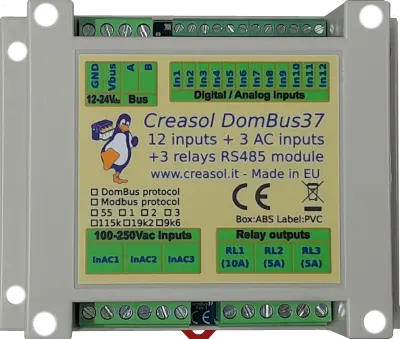 Module designed to be connected to alarm sensors (magnetc contact sensors, PIRs, tampers): it's able to monitor mains power supply (power outage / blackout) and also have 3 relays outputs.
Module designed to be connected to alarm sensors (magnetc contact sensors, PIRs, tampers): it's able to monitor mains power supply (power outage / blackout) and also have 3 relays outputs.
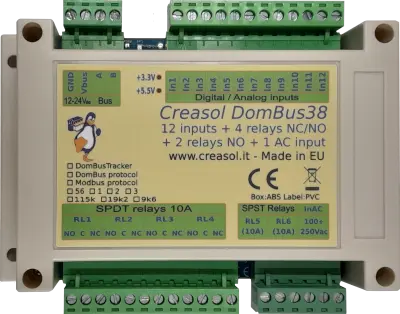 DIN rail module designed for burglar alarm system.
DIN rail module designed for burglar alarm system.
![]() DIN rail module that control azimuth + elevation/tilt motors of a sun tracker, to maximize photovoltaic energy production during the day and seasons.
DIN rail module that control azimuth + elevation/tilt motors of a sun tracker, to maximize photovoltaic energy production during the day and seasons.
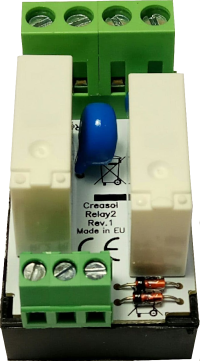 Simple module with 2 relays, to be used with DomBus modules or other electronic boards with open-collector or open-drain outputs
Simple module with 2 relays, to be used with DomBus modules or other electronic boards with open-collector or open-drain outputs
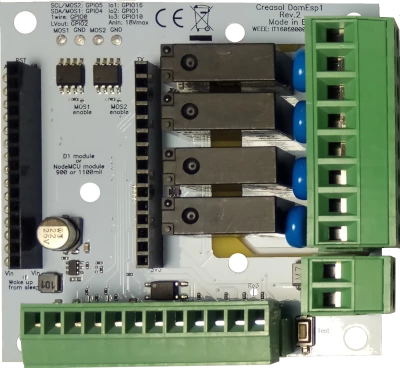 IoT board designed for NodeMCU v3 board using ESP8266 WiFi microcontroller
IoT board designed for NodeMCU v3 board using ESP8266 WiFi microcontroller